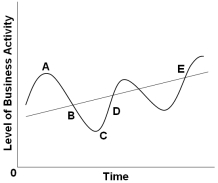A) Price floor
B) Price ceiling
C) Demand determinant
D) Supply determinant
F) B) and C)
Correct Answer

verified
Correct Answer
verified
Multiple Choice
What are the primary effects of cost-push inflation?
A) It raises real output, and redistributes an increased level of real income
B) It reduces real output and redistributes a decreased level of real income
C) It raises real output, but redistributes a decreased level of real income
D) It reduces real output, but redistributes an increased level of real income
F) A) and B)
Correct Answer

verified
Correct Answer
verified
Multiple Choice
Cost-push inflation tends to be characterized by all of the following, except:
A) Rising general price level
B) Falling real output
C) Automatically self-limiting
D) Falling unemployment
F) A) and C)
Correct Answer

verified
Correct Answer
verified
Multiple Choice
Inflation is a rise in:
A) The general level of prices over time
B) The standard of living over time
C) Unemployment over time
D) Real GDP over time
F) A) and C)
Correct Answer

verified
Correct Answer
verified
True/False
Anyone who is not employed is classified as unemployed in the Bureau of Labor Statistics data on the labor force.
B) False
Correct Answer

verified
Correct Answer
verified
Multiple Choice
The unemployed are those people who:
A) Do not have jobs
B) Are not employed but are seeking work
C) Are not working
D) Are not in the workforce
F) B) and D)
Correct Answer

verified
Correct Answer
verified
Multiple Choice
Unemployment that occurs when there is deficient demand for the goods and services of an economy is called:
A) Frictional unemployment
B) Cyclical unemployment
C) Structural unemployment
D) Natural unemployment
F) A) and C)
Correct Answer

verified
Correct Answer
verified
Multiple Choice
If the Consumer Price Index for a certain year is 120, this means that the average price of consumer items in that year was:
A) 20% higher than the average price in the base period 1982-84
B) About $120 per basket of consumer goods and services
C) 120% higher than the average price in the base period 1982-84
D) 20% higher than the average price of the preceding year
F) All of the above
Correct Answer

verified
Correct Answer
verified
True/False
Lenders will be willing to reduce the nominal interest rates on loans if the expected inflation increases.
B) False
Correct Answer

verified
Correct Answer
verified
Multiple Choice
"Depression means idleness. And idleness means loss of skills, loss of self-respect, plummeting morale, family disintegration, and sociopolitical unrest." This quote describes some of the:
A) Consequences of the hyperinflation that accompanies a recession
B) Reasons for the natural rate of unemployment
C) Noneconomic costs of unemployment
D) Characteristics of structural unemployment
F) A) and C)
Correct Answer

verified
Correct Answer
verified
Multiple Choice
The higher the rate of unemployment:
A) The larger is the GDP gap
B) The smaller is the GDP gap
C) The higher is the level of actual GDP
D) The lower is the level of potential GDP
F) A) and B)
Correct Answer

verified
Correct Answer
verified
Multiple Choice
 Refer to the diagram above. The straight line E drawn through the wavy lines would provide an estimate of the:
Refer to the diagram above. The straight line E drawn through the wavy lines would provide an estimate of the:
A) Recession fluctuation
B) Economic growth trend
C) Natural rate of unemployment
D) Recovery trend
F) All of the above
Correct Answer

verified
Correct Answer
verified
Multiple Choice
Which of the following groups has traditionally benefited from unanticipated inflation?
A) Consumers
B) Business firms
C) Federal government
D) Foreign sector
F) A) and C)
Correct Answer

verified
Correct Answer
verified
Multiple Choice
Which of the following countries experienced deflation for several years in the period 2002-2012?
A) France
B) Germany
C) Italy
D) Japan
F) A) and B)
Correct Answer

verified
Correct Answer
verified
Multiple Choice
If the inflation premium is 3% and the real interest on a loan is 4%, then the nominal interest rate is:
A) 1%
B) -1%
C) 7%
E) All of the above
Correct Answer

verified
Correct Answer
verified
True/False
If the economy's actual GDP is greater than its potential GDP, then there is high unemployment in that economy.
B) False
Correct Answer

verified
Correct Answer
verified
Multiple Choice
In which industry or sector of the economy is output least likely to be affected by the business cycle?
A) Housing construction
B) Automobile production
C) Agricultural commodities
D) Capital goods production
F) All of the above
Correct Answer

verified
Correct Answer
verified
Multiple Choice
If the actual rate of unemployment is above the natural rate of unemployment, then potential GDP is:
A) Equal to the GDP gap
B) Equal to actual GDP
C) Less than actual GDP
D) Greater than actual GDP
F) All of the above
Correct Answer

verified
Correct Answer
verified
Multiple Choice
The recurrent ups and downs in the level of economic activity extending over several years are referred to as:
A) Economic phases
B) Business startups
C) Business cycles
D) Noncyclical fluctuations
F) A) and B)
Correct Answer

verified
Correct Answer
verified
Multiple Choice
What is the main problem with mild inflation according to some economists?
A) It reduces the size of the GDP gap
B) It leads to unanticipated deflation
C) It increases frictional and structural unemployment in the economy
D) It diverts productive time towards activities to hedge against inflation
F) A) and C)
Correct Answer

verified
Correct Answer
verified
Showing 121 - 140 of 143
Related Exams